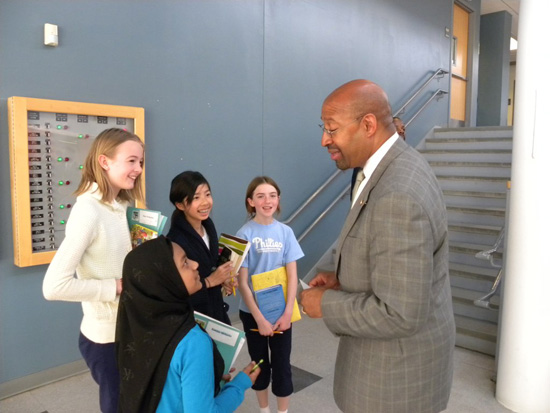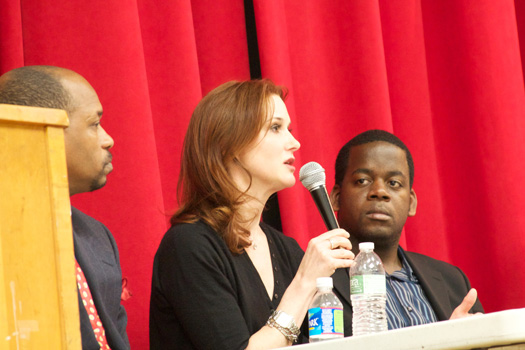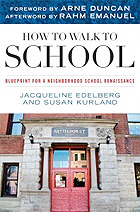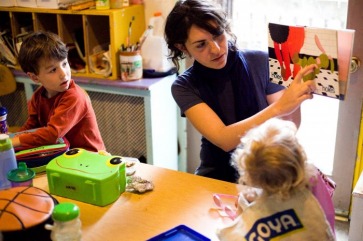
Mayor Michael Nutter talks with students at the Penn Alexander School recently. For the first time, the school will likely have to turn students away.

Enrollment at the vaunted Penn Alexander School at 43rd and Locust has increased every year since it began with 75 students 10 years ago. Now, School District of Philadelphia and Penn Alexander officials have announced, the school’s lower grades are full and many new students will likely not be admitted next year even if they live in the school’s catchment area.
Rumors have been swirling for months that the school, which has operated cooperatively with the University of Pennsylvania since opening in 2001, was at capacity in its lower grades. The District has confirmed that special arrangements have been made with Penn Alexander to limit the number of new students, a break from the District’s usual requirement of reserving spots in neighborhood schools for students who live within the school’s catchment boundaries.
The school’s lower grades, particularly 1-3, are at capacity and students who live in the school’s catchment area, where housing prices have tripled since the school opened, are no longer guaranteed spots.
District spokeswoman Shana Kemp wrote in an e-mail to West Philly Local:
Penn Alexander is at capacity in the lower grades. It typically is the policy that a school must take a student who lives in a catchment, however, once a school reaches capacity, the District can make the decision to assign students elsewhere in order to relieve overcrowding. This is what we have had to do at Penn Alexander. The school was founded in partnership with the University of Pennsylvania, in part, in order to provide enrollment relief to the Lea and Wilson schools, so it is important that we not create a situation of overcrowding there.
A school official who spoke on the condition of anonymity said that there were “no guarantees” that students not already attending the school’s kindergarten would be admitted to the first grade. Some grades beyond first are full as well, the official said. Even siblings of students already attending the school are not guaranteed admission.
Penn provides $1,330 per student annually to keep average class sizes at about 23 students. Currently, the school’s lower grades far exceed that number, with some classes as high as 30.
Registration officially begins on August 15, but District officials recommended that parents of students not currently enrolled at the school investigate other neighborhood schools.
The District estimates that Penn Alexander is at 72 percent of capacity. That number reflects a lopsided enrollment where the classrooms in lower grades are at or above capacity and the upper grades (6-8) are under capacity. The school is designed to accommodate 815 students. Last October, the District reported that 587 students attended the school.
The school official who asked not to be named said an admission lottery is not an option. Likewise, expanding the school’s capacity by using trailers or other temporary classrooms was not planned. The line to sign up for kindergarten at Penn Alexander, which is now the only way to guarantee that a student will be admitted to first grade, began forming this year long before registration began at 8 a.m., requiring parents to spend the night outside the school in freezing temperatures to get a spot.
“I wish we could accommodate every child but we can’t,” said the school official.
Alternatives for those living in the catchment include Samuel Powel Elementary (301 N. 36th St.), which serves students in grades 1-4. But Powel is even more crowded than Penn Alexander. The district reports that, as of October 2010, 236 students attended the school, which has a capacity of 199.
Another alternative is the Henry C. Lea School (47th and Locust), which in recent months has drawn interest from parents who live just outside the Penn Alexander catchment. Lea serves students K-8 and is at about 72 percent capacity, according to the District. Parents who want to improve other schools in the neighborhood have formed the West Philadelphia Coalition for Neighborhood Schools, which has become active at Lea in particular.
The announcement from school and district officials is likely to send parents who have flocked to the neighborhood in recent years scrambling to find school alternatives for their children. The Penn Alexander official sympathized.
“When this school opened we never imagined this would happen,” the school official said.










Recent Comments